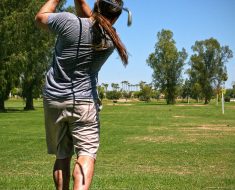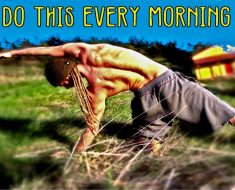Revitalize Your Body: Top 5 Exercises for People Over 60 to Combat Sarcopenia
As we age, maintaining muscle strength becomes crucial for preserving vitality and freedom of movement. Recent research from 2024 has shed new light on combating muscle weakness, scientifically known as sarcopenia. Derived from the Greek term meaning “loss of flesh,” sarcopenia was recognized as a medical condition in 2019 due to its association with disability, frailty, and falls among older adults. However, exciting new studies reveal that sarcopenia is not only preventable but also reversible through targeted exercises.
One particular study highlighted that older adults could reverse muscle loss in just 12 weeks with the right exercises. But it’s essential to note that not all exercises are created equal; incorrect execution or approach can lead to wasted effort or even serious injury. In this blog post, we will explore the five best exercises to reverse muscle loss, along with the gold standard approach recommended by scientists to maximize benefits regardless of age.
Exercise 1: Push-Ups
Push-ups are among the most effective and accessible exercises to strengthen the upper body and improve daily functionality, especially for older adults. This classic movement works the pectorals, shoulders, and triceps while also engaging the core, which is crucial for trunk stability. This translates into greater strength for activities such as pushing, lifting, and even playing with grandchildren, in addition to reducing the risk of falls.
For beginners or those with limited mobility, the modified push-up is an excellent alternative. Place your hands on the floor slightly wider than shoulder-width apart, with knees resting on the ground. Keep your body aligned, forming a straight line from head to knees, and gently bend the elbows to lower the body without letting the chest touch the ground. Aim for two sets of 8 to 10 repetitions.
If this variation is challenging, try wall push-ups. Stand facing the wall with feet about 12 inches away and place your hands on the wall slightly wider than shoulder-width apart. Lean toward the wall by bending your elbows, then push yourself back. This gentle approach effectively begins strengthening the upper body.
For those with more strength and mobility, the full push-up is a great progression. Keep feet on the floor and body aligned from heels to head, engaging the core throughout the movement to protect the spine and maximize benefits. Consistency is key to building strength and improving muscular endurance.
Beyond muscle strengthening, push-ups improve posture, stabilize joints, and increase functional capacity, making tasks like pushing a shopping cart or getting up from a chair easier. Best of all, no special equipment is needed—just a comfortable space and the motivation to begin.
Exercise 2: Squats
Squats are highly recommended for older adults as they strengthen the largest leg muscles: glutes, quadriceps, and hamstrings. These muscles are essential for walking, climbing stairs, and getting up from a chair. This combination of benefits makes everyday tasks like picking something up off the floor or carrying objects easier and safer.
Squats are adaptable to any fitness level. For beginners, a chair can serve as support. Stand in front of the chair with feet shoulder-width apart, bend your hips and knees as if to sit down, keeping your back straight and gaze forward. Once you lightly touch the chair, stand back up in a controlled manner. This reduces joint impact and builds strength safely.
For more confidence, try the traditional squat. Stand with feet aligned with shoulders, arms extended forward or crossed over your chest. Bend knees and hips simultaneously, keeping your back straight, and lower yourself comfortably. Start with two sets of 10 repetitions, gradually increasing as strength improves.
If the goal is to increase difficulty, incorporate a light dumbbell or water bottle as a weight. Hold it close to your chest or let it hang with arms extended during the movement. This adds an extra challenge and further strengthens the core and arms.
Squats improve bone density, reducing osteoporosis risk, and increase blood circulation, contributing to cardiovascular health. Additionally, they efficiently work on balance. Respect your body’s limits and seek guidance from a professional if necessary.
The Gold Standard Approach
Within the study, the gold standard for maximizing exercise benefits was consistency. Among participants monitored over a year, 65% stopped shortly after beginning physical activity, while the remainder maintained continuity, avoiding excess in weight or repetitions but showing up daily. The results were remarkable. Among the 35% who adhered, many overcame muscle weakness, even engaging in activities like hiking or sports they hadn’t done since youth. Be patient, consistent, and never underestimate the power of small daily actions.
Exercise 3: Crunches
Crunches are simple yet effective exercises focusing on strengthening the core, including abdominal and trunk muscles. A strong core maintains stability, improves posture, and reduces back pain.
For beginners, start with a modified version. Lie on your back on the floor or a firm surface with knees bent and feet flat. Place hands gently on thighs or cross them over the chest. Engage core muscles by pulling the belly button toward the floor to alleviate potential lower back discomfort. Inhale deeply, and as you exhale, lift shoulders off the ground using abdominal muscles. Start with two sets of 10 to 15 repetitions, respecting your body’s limits.
If neck discomfort arises, lightly place hands behind your head for support without applying pressure. If a full crunch is too challenging, try a partial crunch by lifting only your head and shoulders slightly off the ground. Remember, quality matters more than quantity; slow, controlled movements deliver better results and prevent injuries.
Crunches not only strengthen abdominal muscles but also improve spinal health, enhance mobility, and contribute to a more active, independent lifestyle.
Exercise 4: Glute Bridge
The glute bridge is an excellent exercise for mobility, focusing on strengthening the glutes, core, and lower back while improving overall stability. It indicates mobility levels; performing 10 to 20 repetitions suggests no difficulty in daily activities like getting out of bed or climbing stairs.
To perform the glute bridge, lie on your back on a firm surface, bend knees with feet flat and hip-width apart. Engage your core by pulling your belly button inward. Inhale deeply, and as you exhale, press heels into the ground, lifting hips toward the ceiling. Squeeze glutes at the top, ensuring effort comes from glutes, not lower back. Hold for 1 to 2 seconds before slowly lowering hips while inhaling.
For beginners, a simpler version involves slightly lifting hips about 1 to 2 inches off the ground, gradually progressing as strength improves. For a greater challenge, try the single-leg glute bridge, which intensifies glute engagement and requires more balance.
Beyond muscle strengthening, the glute bridge improves blood circulation in pelvic and lower back regions, alleviates back pain, and increases hip flexibility. It enhances trunk stability, crucial for daily activities requiring balance.
Exercise 5: Cardiovascular Activity
Cardiovascular activities like dancing, swimming, running, or walking are vital for physical and mental health, especially after 60. These movements keep the heart strong, circulation active, and lungs healthy. They provide energy for daily tasks and reduce risks of cardiovascular disease, diabetes, hypertension, and certain cancers.
Cardio exercise improves physical endurance, making everyday tasks easier and more enjoyable. It boosts mood, reduces stress, and promotes restful sleep. Long-term, it preserves bone density, lowers osteoporosis risk, and keeps joints flexible, essential for avoiding pain and injuries.
If walking outdoors suits you, explore a park or stroll around your neighborhood. Light walks are low-impact, easy to fit into daily routines, and provide essential sun exposure for vitamin D. For a dynamic option, dancing is fun and social, improving coordination and balance.
Enhancing Balance with Jumping
For those wanting to enhance balance, try jumping on an individual trampoline. This low-impact cardiovascular exercise strengthens legs, engages the core, and stimulates balance systems like proprioception and the vestibular system.
No matter the activity, incorporating 30 minutes of cardiovascular exercise at least five times a week can transform health and quality of life.
Frequently Asked Questions (FAQ)
What is sarcopenia?
Sarcopenia is the loss of muscle mass and strength that occurs as we age, leading to increased frailty and risk of falls.
How can I prevent sarcopenia?
Regular exercise, especially strength training, can help prevent and even reverse sarcopenia.
How often should I exercise?
Aim for at least 150 minutes of moderate aerobic activity each week, along with strength training exercises at least twice a week.
Are these exercises safe for everyone?
Always consult with a healthcare provider before starting any new exercise program, especially if you have existing health concerns.
“`






